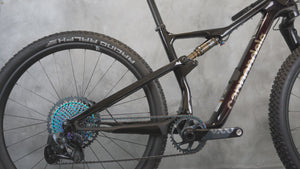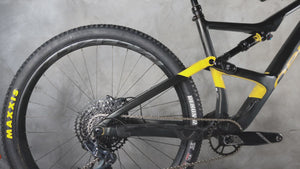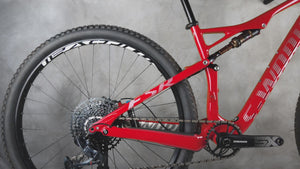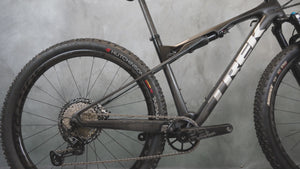Electric transmission vs. Mechanical: Advantages and disadvantages
In this Article
Posted on January 10, 2022
Over the last ten years, electronic groups have become more common. Shimano Dura-Ace, the first electronic transmission launched on the mass market, came out in 2009 and triggered the electronic revolution. SRAM followed with Red Etap in 2015 and stood out by becoming entirely wireless. Now that Shimano, Sram, Campagnolo and FSA all manufacture electronic transmissions and that technology has been tested, refined and developed, almost all high-end bicycles are sold with a charger for transmissions.
The robotic "bzzz" of an electronic derailleur instantly gives any bike the impression of coming from the future. In the era of smartphones, it is logical that the bicycles made from spaces of the spatial era also have an electronic derailleur. But the world of cycling still has many adepts from the mechanical derailleur. Even at The Cyclist House!
SHIMANO DI2 groups have been sophisticated and made ultra-light in the last three generations, and the Latest SRAM AXS Groups New exciting technologies are equipped with unique and 12-speed gear options. More and more road bikes, Gravel and high-end VTTS are equipped with electronic transmissions. If you still use a bike equipped with mechanical controls, you may consider moving to electronic controllers. All this raises the following question: Should we move up a speed? (Sorry.) If you are intrigued by electronic transmissions, here is what you need to know in advance.
We decided to do what anyone else in our situation would: discuss the main advantages and disadvantages of electric transmissions for road bikes and Gravel. Consider this as a guide for beginners on the subject.
Benefits
Precision
To what extent can electronic speed changes be more precise than mechanical speed changes? With a mechanical system, if you press the lever to move from one tray to another, the front mechanism acts in the same way every time. With an electronic system, the front mechanism acts slightly differently depending on the pinion on which you are at that time.
The main difference that most cyclists remark when they switch to electronic speed change is the ease with which it is possible to operate a change of speed. Mechanical transmissions require that the cyclist uses his strength to move a palette and pull a cable to operate a change of speed. Energizers use small derailleur engines that do the job for you and instantly spend speeds by pressing a button. Current models can also customize the speed change settings so that multiple speed changes can be operated by one click, which allows you to find the right relationship faster, with fewer movements and energy.
Take it SRAM ETAP System. When you switch from the small tray to the large tray, the cage shifts slightly to help the chain make the jump. Then, a fraction of a second later, once the chain is at the top, the cage returns inward, in its standard position.
Speed
If you want to go from one side to the other of the cassette with a mechanical speed change system, you must press the lever several times (the number of supports varies depending on the system). With electronic systems, you can switch from one side to the other of the cassette by pressing the lever and holding it down. It's just a little easier.
Campagnolo states that "the speed change times [of the EPS rear derailleur] are now 25% faster than those of the mechanical rear derailleur (only 0.352 seconds to change pinion)".
Possibility to customize
We are not talking here about stickers, moreover you already know our Reviews on the subject. With the Shimano di2 systemYou can customize the speed shift speed and the number of reports that the system passes when you press and hold the lever. You can also intervert the feature mounted lever and the speed descent lever, and even the left lever and lever lever functions. The first SRAM Red Etap system did not customize the change of speed, but the two new 12-speed AXS groups can be customized via a smartphone application.
Less friction
Once a Shimano Di2 or Campagnolo EPS system is properly configured, regardless of the pinion where you are, you never need to adjust the front pedal position to prevent the chain from rubbing on the plates lateral pedal before, as this is done automatically.
Simplicity
The change of speed with an electronic system requires a much shorter lever movement than with the mechanical equivalents. Just press a button without ever needing to move a lever.
The displacement of the levers on a mechanical system is not the most delicate operation in the world, and it can be a little long if you want to change speed throughout the available range. Things are a little simpler with electronic systems.
DI2 and AXS Both allow the use of small change accessories. Shimano calls them "Sprint Shifters" or "Climbing Switch SHIFTERS" and SRAM calls them "Blips". These small buttons allow you to place the shifters at different locations in the handlebars.
Minimal maintenance
With an electronic system, routine maintenance is very limited and you will never need to replace a cable. Little, even adjustment is necessary after the initial configuration.
Even this initial configuration is very easy with the SRAM ETAP system. It is wireless and it is not necessary to pass cables in your frame.
Access to data
GPS, heartbeatters and wattters are now an integral part of the cycling experience. The data is essential for cyclists who are trying to maximize their performance or for those who love the instead and quantifiable side of sport. Another advantage is that electronic transmissions allow you to collect more data on your behavior.
The mechanical speed change has been working well for many years and will continue to do so, and it is considerably cheaper than an electronic configuration. If the benefits we have listed above do not convince you to move on to the electronics, no component manufacturer will stop offering the mechanical speed change away.
The inconvenients
Cost
Electronic groups make incredibly easy speed change, are extremely regular, reliable in the worst conditions, require little maintenance and offer tons of options to improve driving experience. All this is great. But it is impossible to talk about electronic groups Without mentioning the cost.
It is not surprising that electronic groups are more expensive than their mechanical equivalents. If we stick strictly at the recommended prices, you can expect to spend between 400 and 1,000 euros more for an electronic group alone. Most electronic groups (with crankcase) are selling between 1,000 and 3,500 euros, depending on the level of SPECs and the specific components you select. For some, it's the budget for a complete bike.
An important factor that cyclists must take into account is the higher replacement cost of electronic components. For example, a rear derailleur ULTEGRA R8000 DI2 costs more than 100 euros more than a mechanical ultegra derailleur. Electric motors are simply more expensive to produce. High-end models have even higher prices. The Halo Level Red Axs SRAM with its high-tech orbit shock absorber can sell more than 700 euros! If the discipline or the driving style you practice is subject to falls and shocks, an expensive electronic transmission is probably not worth it.
Batteries and charge
Remember to recharge a bike can be a new experience for cyclists accustomed to mechanical transmissions. Some are afraid of being running out of battery before or during an output. All who saw the Netflix documentary "Icarus" will remember the way Bryan Fogel found himself running out of battery during the event around which the film was constructed. It's a nightmare scenario.
Weight
Traditionally, electronic transmissions add weight compared to mechanical systems. The lack of steel cables and complex speed change mechanisms inside the brake levers can make weight gain weight, but the necessary electric motors and batteries often compensate for this difference. ,. The gap is tightened and, depending on the bike and the configuration of the equipment you want to use, the electronics may be lighter in certain situations.
In the case of Shimano, the increment of weight for the electronic speed change is now less than 100 grams.
More complex maintenance
Mechanical speed change systems are relatively simple, which means that you can often solve problems with some basic knowledge and tools. Compare this to the electronic systems that, if they are even simpler to put in place, are not as easy to troubleshoot in case of problems.
You broke a transmission cable during a bike holiday? There is a good chance that you can find a replacement and start rolling again. Pinch an electronic cable during the same holidays? Well, it may be harder to get by.
Conclusion
As you can see, both systems have their own advantages and disadvantages. For most cyclists, mechanical speed change remains the best option. A quality mechanical group can change speed accurately, quickly and reliably. The maintenance is minimal. You may need to adjust or replace a speed change cable once or twice a year. The biggest advantage is the cost. Mechanical groups cost a fraction of the price of electronic groups to purchase, maintenance and repair.
Of course, electronic groups have their advantages. Electronic transmissions change speed faster, more slowly and specifically. They require a lot less maintenance. Technology also allows an incredible amount of personalization and performance monitoring. For many, the slight improvement in performance and efficiency is worth the cost.





































4 comments
Merci pour cette analyse comparative dérailleur mécanique vs électronique.
très intéressante !
Bernard
Vielen Dank – informativ und hilfreich. Ich hatte mit einer Umrüstung geliebäugelt, kann jetzt aber die Kosten besser gegen den Nutzen abwägen.
esto es una pesadilla, ya no puedes elegir una bicicleta de alta gama con transmisión mecánica, en ninguna marca de bicicletas.